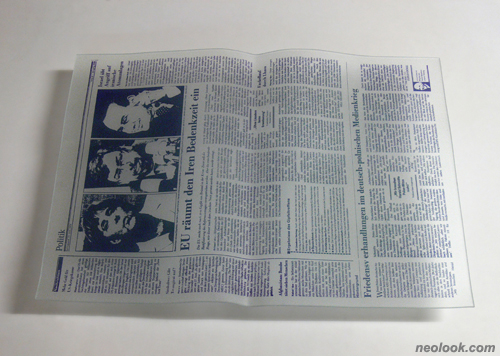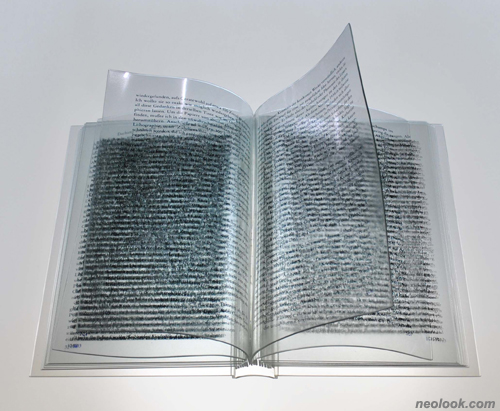- ● homepage
- ● archives
- ● restoration
- ● books
- ● big banners
- ● post board
- ■ neo's search
- ■ about us
- ■ 게재방법 안내
- 개인정보처리방침

- [email protected]
- Tel. 02_335_7922
- Fax. 02_335_7929
- 10:00am~04:30pm
- 월요일~금요일
- 3/3(월) 대체공휴일

2010 얼어붙은 이야기 2010 Freezed Story
황선태展 / HWANGSEONTAE / 黃善台 / sculpture.installation 2010_0410 ▶ 2010_0516 / 월요일 휴관
● 위 이미지를 클릭하면 네오룩 아카이브 Vol.20090920f | 황선태展 으로 갑니다.
초대일시_2010_0410_토요일_05:00pm
관람시간 / 11:00am~07:00pm / 주말,공휴일_11:00am~08:00pm / 월요일 휴관
닥터박 갤러리 Dr.PARK GALLERY 경기도 양평군 강하면 전수리 19-1번지 Tel. +82.31.775.5602 www.drparkart.com
지각과 신체, 죽은 사고의 저장고에 대한 반란 ● 사물과 현상을 자기 나름의 시각에서 바라보고 존재에 대해 새로운 해석을 가하려고 노력하는 작가가 바로 황선태다. 2005년 이후 그가 심혈을 기울이면서 제작하고 있는 유리 작업 시리즈는 이러한 그의 시각이 잘 반영된 노작(勞作)이다. 그의 유리 작업은 컨셉트의 독창성 측면이나 작품의 완성도 면에서 매우 뛰어나며, 그런 만큼 특히 최근 들어서 그 노력에 값하는 명성을 얻고 있다. 몇 년 전 그의 작품을 KIAF 전시장에서 처음 접했을 때, 나는 책을 유리로 만든 그의 독특한 아이디어에 매료되었다. 너무나 마감이 완벽하고 절제미가 있어서 일순 공예미가 두드러진다고 생각했으나, 더 시간을 갖고 지켜보면서 점차 그의 작품이 지닌 개념적인 측면에 관심을 갖게 되었다. ● 황선태의 작업은 그가 독일에 체류했던 이천년 대 초반으로 거슬러 올라가야 그 전모를 살펴볼 수 있다. 즉, 이천년 대 초반에서 귀국을 한 시점인 후반에 이르기까지 십 여 년에 걸친 유학생활의 간난과 신산을 겪으면서도 실험의 끈을 놓지 않으려 했던 의식의 치열함에 대한 고려가 없이는 그의 유리 작업이 태동된 배경을 이해할 수 없다. 왜냐하면 한 사람의 작가로서 그의 관심은 사물의 존재에 대한 자기 나름의 해석에 있으며 그것은 결국 세계에 대한 이해의 폭을 넓히는 일이기 때문이다. 그런 측면에서 볼 때 작가는 사물의 존재에 대한 해석자이며 동시에 현상학자이기도 하다. 그가 독일 유학시절에 했던 설치작업들은 과학자의 시선으로 바라본 사물의 존재에 대한 탐구에 가까우며, 따라서 그것들은 사물과 현상에 대해 다시 생각할 것을 권유하고 있다. 그가 한 채의 집을 임대해 방 전체 구조를 3도의 기울기로 전면 개축하여 관람자에게 새로운 지각 체험의 환경을 제공한 일 등은 이에 속한다.

- 황선태_낮선글자들_유리, 유리샌딩 600_26×39×5cm_2008

- 황선태_낮선글자들_유리, 샌딩, 전사필름 복사_26×39×17cm_2009
사물에 대한 이 일련의 실험은 사물에 대한 그의 집요한 관심에서 비롯된다. 그는 말한다. "사물에 대한 나의 관심은 나의 작업에서 크게 두 가지의 테마로 나눠진다. 첫 번째는 사물의 존재함에 대한 이야기다. 주로 사진 드로잉 작업이나 유리 드로잉 작업을 통해서 이 주제를 다루었다. 존재에 대한 테마는 나중에 유리 설치작업으로 이어지기도 한다. 두 번째는 사물에 대한 분석이다. 즉 사물의 형태 혹은 색등의 외부적 요소, 주변과의 관계 그리고 역사 등의 사물에 대한 관념들의 세부적 분석을 통해 사물을 이야기한다. 이러한 분석 작업은 주로 입체작업(Glasbooks)이나 설치작업을 통해서 실행되었다."(황선태) 사물에 대한 그의 이러한 관심은 2005년 경 유리와의 만남을 통해 매체상의 변신을 겪게 된다. 그는 다시 유리를 공부하면서 유리에 대한 전문적인 지식과 경험을 얻게 되었고, 그렇게 함으로써 현재 보는 것과 같은 스타일의 작품세계를 구축하게 된 것이다. 사실 스타일 상으로 볼 때 한 사람의 작가로서 황선태의 뚜렷한 입지는 유리를 이용한 책 작업에서 비롯된다고 해도 과언이 아니다. 이는 그의 작품이 지닌 독창적인 스타일에 기반을 두고 있다. 그것은 우선 책이라는 사물에 대한 관념을 전복시키는 일과 관련된다. 종이로 만들어진 책을 유리로 전환하는 일은 사물에 대해 새로운 시선으로 바라볼 것을 권유하는 일이기 때문이다. 그럼으로써 작가는 결국 사물이라는 것이 고정된 것이 아니라, 시각에 따라서 얼마든지 개념이 뒤바꿔 질 수 있다는 사실을 촉발시키는 촉매자가 되는 것이다. 그의 유리 작업은 그것이 책 자체가 됐든 아니면 사물의 이미지가 됐든지 간에 "사물이 단지 거기에 있음"을 암시한다. 알다시피 유리로 된 그의 책은 용도가 폐기된 하나의 사물에 지나지 않는다. 한 장 한 장 넘기며 볼 수 없는 책, 그것은 다시 말해서 기능성을 상실한 하나의 사물이 아닌가. 우리는 여기서 그의 유리 책이 문명의 기나 긴 과정을 통해 문화사적 가치를 획득한 인류의 창안물이 아니라, 하나의 심미적 대상이거나 아니면 사물의 사물성에 대한 깊은 사유를 통해 존재에 대한 새로운 각도에서의 해명을 시도한 쾌거라고도 볼 수 있다. "내 평면 작업 속의 모든 사물들은 희미하다. 그리고 사물들의 세부적 성격은 생략되어 있다. 그림 속의 사물들은 자신의 자잘한 이야기와 경험들을 숨기고 단지 거기에 있다. 그 때문에 그림 속의 사물들은 자신의 존재감을 더 분명히 한다. 한 사물의 세부적인 정보가 많으면 많을수록 그 사물의 성격이 강하게 표출되고 자잘한 이야기가 사물의 존재 그 자체로부터 독립하여 우리의 사고는 사물로부터 어떤 특별한 선입관에 묶이게 된다."(황선태)

- 황선태_얼어붙은이야기_유리, 유리샌딩 600_26×39×20cm_2008

- 황선태_얼어붙은이야기-미술사_유리, 유리샌딩, 전사지_26×39×20cm_2009
마치 간유리처럼 유백색의 희미한 박스 속에 갇힌 이미지들과 문자들의 행렬은 부유하는 듯한 환경 속에 자신의 몸을 숨기고 있다. 여기서 촉발되는 유별난 지각은 관람자에게 새로운 미적 체험을 안겨준다. 그것은 마치 어느 날 갑자기 사물이 희미하게 보이는 경험을 했을 때의 충격을 상기시킨다. 사물은 그대로 현전하되, 지각 기관에 고장이 생김으로써 겪게 되는 이 충격은 그가 이야기하고 있듯이, "그 때문에 그림 속의 사물들은 자신이 존재감을 더 분명히 하는" 역설을 유발시키는 것이다. 여기서 알 수 있는 것은 그의 작업이 결국은 주체와 객체 사이의 관계에 대한 현상학적 해명과 관련되고 있다는 사실이다. 그가 위 글의 말미에서 사물에 대한 독립, 곧 '특별한 선입관'으로부터의 탈피를 주장하고 있는 것은 이러한 현상학적 해명과 직결되는 부분이다. 그의 유리 책은 기능성을 상실한, 그리하여 '몸성'이 더욱 강조될 수밖에 없는 존재론적 지위를 차지하고 있다. 그의 유리 책은 하나의 신체이다. 그것은 넘길 수 없고 단지 바라봐야만 하는 하나의 타자이며, 견고한 신체다. 그것은 죽은 사고의 저장고이자 문명과 문화의 퇴적물에 불과한 책의 개념을 전복시키려는 불온한 음모이기도 하며, 동시에 박물관의 상징인 박스를 빌어 박물관의 의미에 대해 이의를 제기하는 당돌한 시도인 것이다. ■ 윤진섭

- 황선태_녹색글자들2_유리, 유리샌딩_35×52cm_2008

- 황선태_녹색글자들_유리, 유리샌딩_35×52cm_2008
Perception, Body, and Revolt Against "the Dead Idea" ● Hwang, Seon-Tae is the artist who makes an effort to observe things or objects that influence his existence. Through this body of work displays a new interpretation of what he observes. ● Hwang's hard work and dedication is reflected by his glass work series that he started in 2005. His own interpretation of life and his surroundings makes the glass work series one of Hwang's most unique reflections of his own style and skills. ● His glass works are excellent in terms of distinctiveness of concept and execution. These glass works are made with utter delicacy and perfection which suits his efforts and reputation. ● Fascinated by Hwang's unique idea of making books from glass, first seen at the KIAF exhibition several years ago, got the attention of many. His exhibition showed fine workmanship as it stood out because of the moderation by which it was made. The perfect finished end product on exhibition was what really made the shift to a conceptual approach to art. ● Seon-Tae Hwang's lived in Germany for ten years from 2000. This gave him the opportunity to fully come to ground with his own potential as an artist. Hwang's social and financial circumstances at this time in Germany played a tremendous role in the development of Hwang's art. ● His understanding of Germany and foreign cultures has broadened Hwang's perspective as he opened up to people with different backgrounds. Through human observation, Hwang has been inspired to create objects of immaculate quality. In that respect, an artist is not only the interpreter of his existence of objects but also a phenomenologist. ● His installation works that he created during his study in Germany are tantamount to the exploration of the existence of objects that he looked from the standpoint of scientist, and thus, they invite us tore think about the objects and phenomenons. One of the examples is the house that he rented, which he remodeled by tilting the entire room structure by three degrees to provide the experience with the new perception for the audiences. Those series of experiment with object begin with his intensive interest in objects. According to him, "My interest in objects focuses largely on two themes when creating artworks. First, it is the story about the existence of object. I deal with this theme mostly through photo drawing or glass drawing. The theme about existence sometimes leads to the glass installation later. Secondly is the analysis of object. In other words, the story about the object unfolds through the detailed analyses on the external factors such as the shape or color of objects and the notions about objects like their relationship with the surrounding environment and history, and so forth. Those analyses have been carried out mainly through three-dimensional works (Glass books) or installation works."(Hwang Seon-Tae, excerpted from the artist's notebook) ● His encounter with glass in 2005 led him to adopt a new approach to the media. He acquired the knowledge and experience related to the glass while he majored in glass handicraft again, and by doing so, he developed his own world of art with his present style. It is no exaggeration to say that the distinctive artistic identity of Hwang Seon-Tae is built around his glass book. That is founded on the unique style of his artworks. That is related to overthrowing or breaking the mold of stereotyped concept of the book. Because making books from glass, instead of paper, invites us to adopt new perspective toward objects. In that way, the artist serves the role of catalyst for promoting the fact that the fixed concept can be overthrown anytime depending on the perspective. ● His glass works imply that the objects stay where they are, whether they are books themselves or take the image of object. As it can be seen clearly, his glass books are nothing but the objects which lost their purpose as books. They are the books that cannot be read by thumbing through the pages. In other words, they are the objects that lost its function. ● We can find that his glass books are aesthetic objects and represent a splendid achievement in interpreting the existence from new angle through in-depth consideration of the characteristics of objects, rather than being the sort of human creation which acquired cultural and historic value through long process of civilization. "All objects in my two-dimensional works are blurry. And their detailed characteristics are left out. The objects in the painting conceal their trivial stories and experiences and are left where they are. Thus, the objects in the painting try to make their presence more clear. The characteristics of object are expressed more intensively and their trivial stories are liberated from the existence of object itself, making our ideas molded in the straightjacket of certain special prejudice, when more information about the object is available in detail." (Hwang Seon-Tae, excerpted from the artist's notebook) ● The procession of images and letters are concealing themselves in the environment which seems to be floating, being confined to the blurry milky-white box like polished glass. The extraordinary perception which is stimulated here provides new aesthetic experience to the audiences. That is reminiscent of the shock that one may experience when he or she finds something looks blurry all of sudden. This shock arising from failure in the perceptive organ causes the paradox that solidifies the presence of the objects in the painting though they are left where they are. ● Here, we can eventually find that his works are associated with the phenomenological explanation about relationship between subject and object. His comment of the liberation from objects in the preceding phrase, namely his assertion for the escape from the special stereotype, is directly linked with such a phenomenological explanation. ● Having lost its function, his glass book has the ontological status that cannot but put an added emphasis on the characteristics of body. His glass book is another body, a different body and solid body which cannot be read by leafing through the pages but only has to be looked at. ● That represents a bold attempt to overthrow the concept of the book which is nothing but the reservoir of dead ideas and the deposit of civilization and culture, and constitutes a challenge against the meaning of museum which he expressed by using the glass cover case that is the symbol of museum. ■ Yoon, Jin Sup
Vol.20100413d | 황선태展 / HWANGSEONTAE / 黃善台 / sculpture.installation

